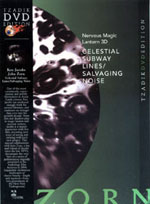|
|
 |
Dusted Reviews
Artist: Jacobs/ Zorn / Ikue Album: Celestial Subway Lines / Salvaging Noise Label: Tzadik Review date: Nov. 22, 2005 |

|
|
|
 |
In 2004, experimental filmmaker Ken Jacobs completed the definitive version of his sprawling masterwork Star Spangled to Death. Four decades in the making and six-and-a-half hours in length, the pastiche of found footage and performance art skewers American hypocrisy even as it celebrates the magical possibilities of the moving image, functioning as a kind of jig in the belly of hell. “It is a work of such scope and ambition,” wrote P. Adams Sitney in 1974, when Jacobs’ epic was a mere fraction of its current running time, “that despite its negativity and its aesthetic of failure, it participates in the myth of the absolute film.” Since completing what many consider his life’s work, Jacobs has made a break from figurative cinema and plunged in the direction of a new kind of absolutism – the capital-A variety that animation pioneer Mary Ellen Bute once defined as the stimulation of an aesthetic idea through picture and sound. “We view an Absolute Film,” wrote Bute, “as a stimulant by its own inherent powers of sensation, without the encumbrance of literary meaning, photographic imitation, or symbolism. Our enjoyment of an Absolute Film depends solely on the effect it produces.” Art, as they used to say, for art’s sake.
Celestial Subway Lines/Salvaging Noise, the DVD version of a live multi-media collaboration between Jacobs and musicians John Zorn and Ikue Mori, strives for the aesthetic purity and symbiotic balance that Bute describes, although it does so independent of the film medium. For the visual component of the work (patched together from four separate performances at the Anthology Film Archives in New York), Jacobs utilizes a modified version of the 19th century Magic Lantern, a device used to project still images like the modern slide projector. By spinning the shutter (as opposed to moving a strip of celluloid), Jacobs creates a phantasmagoric effect as bizarre and fantastic as the filmic manipulations he achieved in works like Tom, Tom, the Piper’s Son. And unlike experimental filmmakers as divergent as Stan Brakhage and Ernie Gehr, Jacobs does not value the primacy of image over sound. “Vast spaces ache to be inhabited, for sound to enter,” says Jacobs. “Indeed, for this transcendent Lower East Side–imbued ramble, they call specifically for Zorn and Ikue.”
What Zorn and Ikue do to “inhabit” Jacobs’ images is intriguing. Their morphing, digitally remixed concrète score is characteristically confrontational – less rhythmically structured than Ikue works like Hex Kitchen (Tzadik, 1995), much of the composition is nevertheless anchored to the furnace-blasts of bass and roiling sheets of noise that the downtown scene veteran often layers as foundation. Into this thick miasma, Zorn breathes creaking voices, echoing chimes and dissolving arpeggios from unknown instruments, which repeat at the rapid speed of Jacobs’ twirling shutter. Like the images they accompany, the abstract sounds seem to rotate around uncertain axes, with wisps of choral voices sharpening in the mix before becoming subsumed by tinny harpsichord notes, bowed scrapings or hysterical blasts of air. Though never as extreme as the most pummeling moments in Zorn’s Kristallnacht, this harsh, amorphous work is also a far cry from the composer’s manic homages, or his speed tours of eclectic genre conventions.
Zorn and Ikue’s score is relentlessly modern – its processed textures convert eastern chimes into falling droplets of 21st century data, and its urban-industrial tones would be impossible to source from a simple machine. As such, they pull Jacobs’ abstract images into new contexts. In interviews, the filmmaker clearly delights in the rudimentary nature of his faux-19th century device: “It is a technique that could've been employed before the advent of film, and way before electronics,” says Jacobs. “As soon as light could be concentrated and focused through a lens in a surrounding darkness against a reflective surface, and a shutter could be made to spin, it was at hand.” Like DW Griffith's silents, many of Jacobs’ images are framed in an iris, and their exaggerated flicker lends them a magical quality of anachronism. When viewed separate from their score, the twisting, rotating, tissue-thin shapes assume organic permutations in the imagination – capillary-threaded eyes, molten lava flows and cumulonimbus clouds. Transformed by their aural accompaniment, the shapes assume newly menacing configurations – storm clouds seen on radar, or cancer cells multiplying inside an electron microscope. Rotating in time to a arrhythmic, cacophonous symphony, Jacobs’ images push at the paradox of the celestial subway, a realm where the infinite and the infinitesimal flicker in the mysterious interplay between light and shadow.
By Nathan Hogan
|







